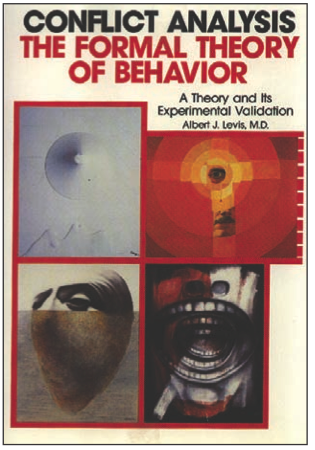Syndromes and Relational Modalities
Wellness Syndromal Diagnostic Categories
The Formal Theory identifies four Relational Modalities as wellness syndromal relational diagnoses, a personality typology as the alternative to DSM5’s non-psychodynamic, phenomenological, illness-based, stigmatizing diagnoses.
The syndromal structure of the thought process is determined by the motivation to reduce the unpleasantness of psychic tension. The six-role process is experienced as the satisfaction of resolution as social adjustment. The unconscious process is a physiological automatism anabolizing or converting the psychic energy of conflict to the orderly state of resolution as the state of rest. The unconscious may be viewed as a pump converting psychic tension into normative conformity or challenge.
Diagnoses identify the unconscious as a syndromal six-role-state conflict-resolution process resolving conflicts along the four alternative relational modalities. These are determined by two formal relational dichotomies: reciprocal states as passivity versus activity and opposite attitudes as cooperation versus antagonism. These states are modified by the third dichotomy of wellness versus illness: alienation with high psychic tension versus mutual respect with low tension.
This methodology identifies four relational psychodynamic or syndromal modalities dominance and submissiveness, cooperative and antagonistic variations, as a wellness personality typology though also accounting for illness countering DSM’s symptom-clusters illness-based non-relational, non-psychodynamic diagnoses.
The alternative modalities differ in conflict resolution effectiveness: Submissive antagonism is accompanied by increased psychic tension. Elevated psychic tension may lead to decompensation and relational modalities related psycho-pathologies: Antagonistic submissiveness may accrue hostility and depression, escapist conducts in dealing with stressors. Antagonistic dominance evokes anxiety, paranoid fears, defensiveness, controls, and reversals as social setbacks.
The submissive individual needs to settle differences pleasantly, while the dominant wishes to confront one’s paranoid fears. The normative deviations related corrective balance guide a person returning to the rest state along opposite behaviors: Dominance entails the need for reduction of power, submissiveness entails pursuing assertiveness. The syndromal and relational aspects of diagnoses explain and also entail psychotherapeutic interventions: i.e. identifying insights entails corrective activities to deliberately, consciously reduce conflicts.
The relational modalities are graphically portrayable as a sine-wave illustrating the syndromal structure and vectors within concentric circles portraying the relational modality diagnosis.
This typology explains the five-factor analysis of traits as four interrelated modalities plus the psychic tension measure.
The typology is Differences between the formal typology and DSM 5 diagnoses
DSM’s personality types identify psycho-pathologies and do not identify wellness personality types. Unlike the DSM5, the FT’s relational diagnostic categories generate insights. The syndromal structure and the relational formal alternatives qualify the transformation of a conflict to its resolution with measurable parameters. Relational modalities account for psychodynamic understanding of wellness and illness. Relational diagnoses are applicable to individuals, and cultures accounting for their respective behaviors and values.
DSM diagnoses are unrelated to each other. FT’s personality types are interrelated.
Relational modalities are genetically determined, developmentally modified and culturally reinforced.
The Conflict Resolution Process is manifested syndromally, psychodynamically as a sequence of interrelated emotions and behaviors that lead to alternative types of conflict resolution along the formal relational operations. The formal alternatives of passivity to activity, and antagonism to cooperation, yield four alternative relational modalities: Dominance and subordinacy, qualified as cooperative and antagonistic alternatives.
The four relational distinctions are wellness personality types manifesting in all populations and cultures. These diagnostic categories are remarkably useful in helping the public understand psychology and oneself. These four personality types have been identified by traditional philosophies and by psychologists but they are not featured in the diagnostic statistical manual of the psychiatric association.
The Bible has detected these modalities, as shown in the four children of the Passover service, the Haggadah. The children are identified as the Wise and Wicked, the Silent and the Simple. The Jewish tradition recognized the importance of the innate attitudes in the formative cultural journey of the Exodus, preparing the travelers for the journey through the desert. Dominant Cooperative: Wise; Dominant Antagonistic: Wicked; Submissive Cooperative: Simple; Submissive Antagonistic: Silent.
These four universal distinctions are re-discovered in the Oz StoryDominant Cooperative: Dorothy; Dominant Antagonistic: Cowardly Lion; Submissive Cooperative: Scare Crow; Submissive Antagonistic: Tin Man.
Henry Gorski detected it in his self-transformative images of emotions as illustrated on the jacket of the Formal Theory textbook.
Dominant Cooperative: Crucifix; Dominant Antagonistic: Screaming Mouths;
Submissive Cooperative: Mouth of God Kissing Adam; Submissive Antagonistic: Adam's Mouth Submerged.
Ancient Greek Personality typology marks similar distinctions between four relational modalities. Dominant Cooperative: Sanguine; Dominant Antagonistic: Choleric; Submissive Cooperative: Phlegmatic; Submissive Antagonistic: Melancholic.
These examples validate the Formal Theory's Relational Modalities as diagnostic categories and entail the need for programs of emotional education clarifying the nature of the unconscious and of its alternative ways of resolving conflict., the relational modalities.







